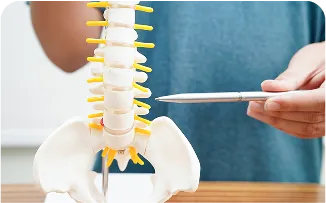Minimally Invasive Spine Procedures
Advanced techniques to relieve pain and speed recovery.

Targeted Relief Through Less Invasive Care
At Spinal Diagnostics, we specialize in minimally invasive procedures that address chronic spine and nerve pain with precision and care. These techniques are designed to reduce discomfort, restore mobility, and minimize recovery time without the need for traditional open surgery.
Whether you’re dealing with spinal stenosis, nerve compression, or joint-related pain, our team offers advanced, image-guided treatments tailored to your specific condition. By focusing on targeted interventions, we help you return to your daily activities with greater ease and comfort.
Targeted Relief Through Less Invasive Care
At Spinal Diagnostics, we specialize in minimally invasive procedures that address chronic spine and nerve pain with precision and care. These techniques are designed to reduce discomfort, restore mobility, and minimize recovery time without the need for traditional open surgery.
Whether you’re dealing with spinal stenosis, nerve compression, or joint-related pain, our team offers advanced, image-guided treatments tailored to your specific condition. By focusing on targeted interventions, we help you return to your daily activities with greater ease and comfort.

Minimally Invasive Treatment Options
Explore the minimally invasive procedures we offer to treat chronic pain and improve your quality of life.
Stellate Ganglion Block
Targeted injection to the stellate ganglion that helps reduce pain and relieve nerve-related symptoms.
View More
Vertiflex™ Procedure
Implant-based treatment that relieves pressure on spinal nerves caused by lumbar spinal stenosis.
View More
MILD® Procedure
Minimally invasive lumbar decompression that removes bone and ligament to relieve nerve pressure.
View More
Occipital Nerve Block
Injection therapy targeting the occipital nerves to alleviate chronic headaches and migraines.
View More
ZIP® Procedure
Minimally invasive spinal fusion technique that stabilizes the spine and reduces pain from spinal instability.
View More
Why Choose Spinal Diagnostics?
Patients choose Spinal Diagnostics for our comprehensive approach, accurate diagnostics, and compassionate care. We stay at the forefront of interventional procedures and are committed to improving your quality of life without opioids or invasive surgeries.
Proven Medical Expertise
We bring years of clinical experience in pain management and interventional procedures.
Constant Innovation
We use the latest techniques and technology to ensure safe, effective treatment.
Compassionate Care
We listen, understand, and treat every patient with empathy and respect.
Personalized Plans
Each treatment is tailored to your condition, goals, and lifestyle.
Discover what's behind your pain.
Explore the conditions we treat and find the answers you’ve been looking for.
Discover what's behind your pain.
Explore the conditions we treat and find the answers you’ve been looking for.







